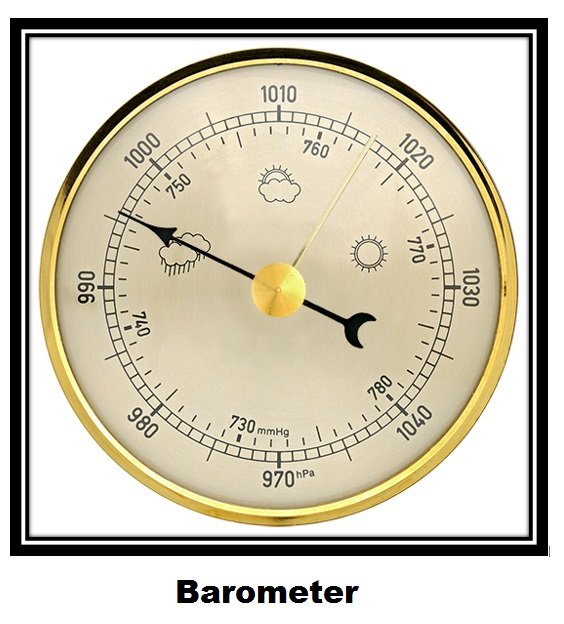Barometer, types, working, uses
Barometer, types, working, uses

Barometer, types, working, uses
What is berometer?
A barometer is a measuring instrument used in physics to measure atmospheric pressure. It is often used in meteorology to predict weather patterns and changes.
Who invented berometer?
The first form of barometer was created in 1643 by the Italian physicist Evangelista Torricelli, and it measures mercury pressure. Torricelli did his first barometric experiments with a tube filled with water.
Types of berometer:
There are different types of barometers used to measure atmospheric pressure. Here are some common types:
Mercury Barometer:
This is the traditional and best known type of barometer. It consists of a glass tube filled with mercury, which is turned upside down and placed in a mercury tank. The height of the mercury column in the tube indicates the atmospheric pressure.
Aneroid barometer:
An aneroid barometer uses a flexible metal box called an aneroid cell that expands or contracts as atmospheric pressure changes. The voltage of the cell is converted into readings on the dial. Aneroid barometers are often compact and portable and do not require liquids.
Digital Barometer:
Digital barometers use electronic sensors to measure atmospheric pressure. These sensors can be based on different principles such as piezoelectric, capacitive or strain gauge. Pressure readings are displayed digitally on the screen. Digital barometers often offer additional functions, such as temperature readings and historical pressure trends.
Water Barometer:
This type of barometer uses water instead of mercury. It consists of a glass tube partially filled with water and placed upside down in a container of water. Atmospheric pressure causes the water level in the pipe to rise or fall, thus measuring the pressure.
Barograph:
A barograph is a specialized barometer that records changes in air pressure over time. It usually uses a mechanism that converts pressure changes into movement of the pen on a rotating drum or chart, allowing pressure changes to be visualized.
These are just a few examples of commonly used types of barometers. Each type has its own advantages and uses, and the choice of barometer depends on factors such as accuracy requirements, portability, and specific use cases.
How does a barometer work?
How a barometer works depends on balancing the weight of mercury in a glass tube against atmospheric pressure.If the weight of mercury is less than atmospheric pressure, the mercury level will rise.And if the weight of the mercury is greater than atmospheric pressure, the mercury level will drop.The rise and fall of mercury is measured using an inch scale marked on a glass tube.
How to make a bermometer?
Predict the type of weather in your area by looking at the barometer. As mentioned earlier, a barometer is a type of instrument that measures atmospheric pressure. Low pressure usually means rainy weather while high pressure means mild and cool weather. Well, you don't have to be a weather expert to understand weather conditions.
Build your barometer by collecting the items listed below and diligently following the steps listed.
Things you need:
Highlighter
Sturdy paper - postcard
Hay
Transparent whiskey
Gum
Can
Pair of scissors
Balloon
Procedure:
Take a balloon and cut the top off.
Take a rubber band and use it to secure and stretch the cut ball over the pot.
The straw is tied on top of the balloon (use tape) so that one third hangs over the edge.
Using the scale, draw three lines on the paper spaced about half an inch apart. These lines are labeled as low, medium, and high.
The paper should be glued to the back of the jar with the straw facing the temperate side.
Place this unit indoors on a flat surface.
In a low-pressure situation, the balloon inflates and the straw begins to point downwards. This is due to differences in air pressure, because the air inside has a higher pressure than outside, causing it to expand and thus expand the balloon outward.
Likewise, the outside air will push the balloon inward in a high-pressure environment and the straw will point straight up. This is because the air in the balloon has a low pressure. In general, low pressure results in bad weather, while high pressure results in good weather. By combining various factors such as wind direction and speed and precipitation, a complete weather forecast can be created.
Uses of berometer:
An instrument known as a barometer is used to measure atmospheric pressure, sometimes called barometric pressure. The atmosphere consists of the layers of air that are wrapped around the earth. This air has weight and pushes against everything it touches as gravity pulls it toward Earth. Barometers measure this pressure. When it comes to weather forecasting, barometers are crucial. A barometer can measure atmospheric pressure and can tell us whether the atmospheric pressure is increasing or decreasing. A meteorologist can use this information to determine whether a storm is approaching or leaving.
What's Your Reaction?





















